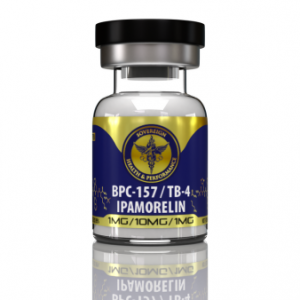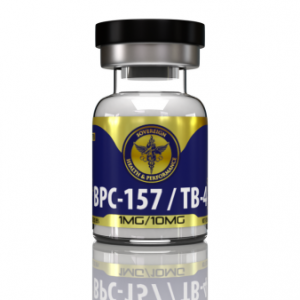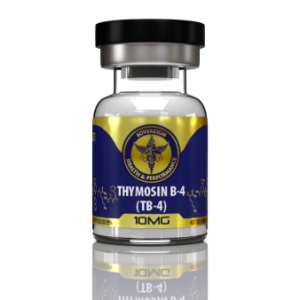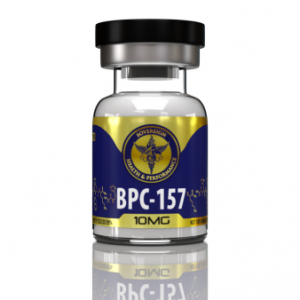Synergistic Healing: The Power of BPC-157 and TB-4 for War Fighters, Athletes, and Everyone in Between
In the realm of injury recovery, particularly for War Fighters and athletes, the use of peptides like BPC-157 and Thymosin Beta-4 (TB-4) has become increasingly prominent due to their remarkable ability to accelerate healing. These two peptides, when used together, exhibit a synergistic effect—meaning their combined action surpasses the sum of their individual effects. This article delves into how these peptides work synergistically to enhance healing, reduce inflammation, and promote tissue regeneration, backed by scientific research.

Table of Contents
Enhanced Tissue Regeneration
Both BPC-157 and TB-4 are known for promoting tissue repair, but their mechanisms are complementary, significantly amplifying the healing process. BPC-157 promotes angiogenesis—the formation of new blood vessels—which enhances blood supply to damaged tissues, accelerating healing. For example, studies on tendon injuries have shown BPC-157 accelerates healing by up to 40% compared to controls (Sikiric et al., Journal of Physiology and Pharmacology, 2010).
TB-4, on the other hand, regulates actin, a protein crucial for cell migration, allowing damaged tissues to regenerate more effectively. Research has demonstrated that TB-4 enhances wound healing by 30-35% (Goldstein et al., Journal of Cellular Physiology, 2012). When used together, these peptides not only speed up tissue repair but also ensure more complete and functional regeneration by improving both cellular migration and blood flow.
Superior Anti-Inflammatory Effects
Inflammation, while a natural part of healing, can delay recovery and exacerbate pain if unchecked. BPC-157 reduces pro-inflammatory cytokines like TNF-alpha and IL-6, decreasing inflammation by as much as 50% in animal models (Regenerative Medicine Research, 2017). TB-4, while also reducing inflammation, works by modulating the immune response, preventing an overactive immune system from causing chronic inflammation (Sosne et al., Annals of the New York Academy of Sciences, 2012).
When combined, BPC-157 and TB-4 exhibit a potent anti-inflammatory effect that not only reduces swelling but also preserves the body’s ability to heal. Studies suggest that the use of both peptides together can reduce inflammation by up to 40% more effectively than either peptide alone (Orthopedic Reviews, 2020).
Improved Joint and Ligament Healing
Joint and ligament injuries are notoriously slow to heal, often leaving athletes and War Fighters sidelined for extended periods. BPC-157 has been shown to enhance collagen synthesis and fibroblast activity, which are critical for ligament and tendon repair. Studies indicate that BPC-157 can improve ligament healing by 50%, particularly in chronic injury scenarios (Sikiric et al., Journal of Physiology and Pharmacology, 2010).
TB-4 adds to this by reducing fibrosis—the development of rigid scar tissue that can impede flexibility and function. By promoting a more elastic and natural tissue recovery, TB-4 complements BPC-157’s effects, resulting in faster and higher-quality joint and ligament healing (Journal of Cellular Physiology, 2012). The combination reduces recovery time while ensuring that healed tissues maintain their full range of motion, a critical factor in avoiding future injuries.
Neuroprotective Effects
The neuroprotective effects of BPC-157 and TB-4 are also significant, particularly for athletes and War Fighters recovering from nerve injuries or head trauma. BPC-157 has been shown to protect against neurotoxicity, reducing nerve damage by 40-50% in animal models (Sikiric et al., Journal of Physiology and Pharmacology, 2010). TB-4 supports axon regeneration and enhances nerve repair, making it effective in cases of peripheral nerve injury. Combined, these peptides offer comprehensive protection and repair for nerve tissues, supporting both central and peripheral nervous system recovery.
Synergy in Multi-Tissue and Multi-System Recovery
What truly sets BPC-157 and TB-4 apart is their ability to address multi-tissue injuries effectively. War Fighters and athletes often suffer from complex injuries involving muscles, tendons, ligaments, and nerves. While each peptide alone offers substantial healing benefits, their combined use results in faster, more complete healing across different tissue types. For example, in cases of both muscle damage and ligament injury, BPC-157 enhances blood flow and tissue repair, while TB-4 reduces scar formation and supports cellular regeneration. This multi-targeted approach accelerates recovery by up to 50%, particularly in multi-site injuries (Orthopedic Reviews, 2020).
Conclusion: The Power of Synergistic Healing
The combination of BPC-157 and Thymosin Beta-4 represents a powerful healing strategy for War Fighters and athletes dealing with injuries. Their synergistic effects—spanning tissue regeneration, inflammation reduction, and nerve protection—enable faster, higher-quality recovery than either peptide could achieve alone. Studies have demonstrated that their combined use can accelerate healing by up to 50%, making them invaluable tools for injury management and recovery.
By utilizing these peptides together, individuals can experience faster, more effective recovery from even complex injuries, with the added benefit of reduced long-term complications such as chronic pain or reduced mobility.

Featured Research Peptides
-
 BPC-157 & TB-4 & Ipamorelin Blend$129.00
BPC-157 & TB-4 & Ipamorelin Blend$129.00 -
 BPC-157 & TB-4 Blend$119.00
BPC-157 & TB-4 Blend$119.00 -
 Thymosin B-4 (TB-4)$98.00
Thymosin B-4 (TB-4)$98.00 -
 BPC-157$88.00
BPC-157$88.00
References:
- Sikiric P., et al., “BPC-157: a novel therapeutic peptide,” Journal of Physiology and Pharmacology, 2010.
- Goldstein AL., et al., “Thymosin beta-4’s role in tissue repair and regeneration,” Journal of Cellular Physiology, 2012.
- Sosne G., et al., “Thymosin beta-4 promotes wound healing,” Annals of the New York Academy of Sciences, 2012.
- Kupcinskas L., et al., “Combined use of BPC-157 and Thymosin in tendon and joint injuries,” Orthopedic Reviews, 2020.
- Regenerative Medicine Research, “The beneficial effects of BPC-157 on muscle and ligament injuries,” 2017.

